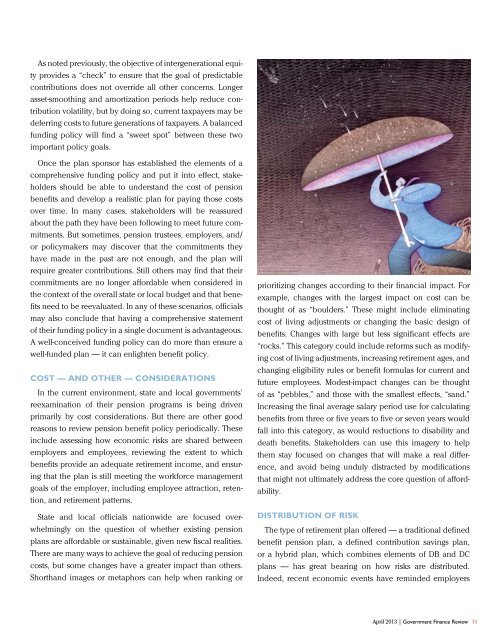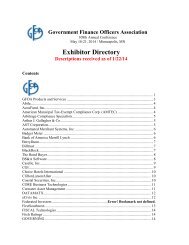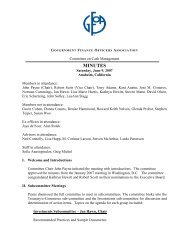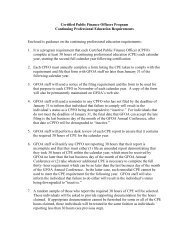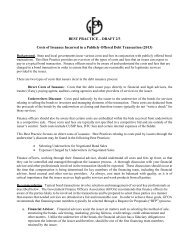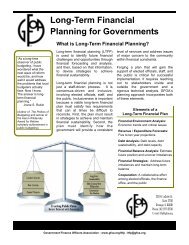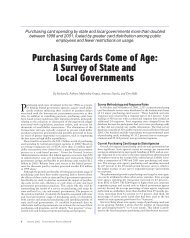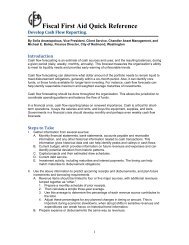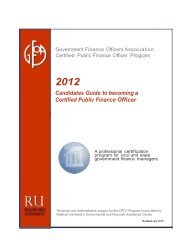PubliC-SECtor PEnSion PlanS Major Challenges & Common-Sense ...
PubliC-SECtor PEnSion PlanS Major Challenges & Common-Sense ...
PubliC-SECtor PEnSion PlanS Major Challenges & Common-Sense ...
You also want an ePaper? Increase the reach of your titles
YUMPU automatically turns print PDFs into web optimized ePapers that Google loves.
As noted previously, the objective of intergenerational equity<br />
provides a “check” to ensure that the goal of predictable<br />
contributions does not override all other concerns. Longer<br />
asset-smoothing and amortization periods help reduce contribution<br />
volatility, but by doing so, current taxpayers may be<br />
deferring costs to future generations of taxpayers. A balanced<br />
funding policy will find a “sweet spot” between these two<br />
important policy goals.<br />
Once the plan sponsor has established the elements of a<br />
comprehensive funding policy and put it into effect, stakeholders<br />
should be able to understand the cost of pension<br />
benefits and develop a realistic plan for paying those costs<br />
over time. In many cases, stakeholders will be reassured<br />
about the path they have been following to meet future commitments.<br />
But sometimes, pension trustees, employers, and/<br />
or policymakers may discover that the commitments they<br />
have made in the past are not enough, and the plan will<br />
require greater contributions. Still others may find that their<br />
commitments are no longer affordable when considered in<br />
the context of the overall state or local budget and that benefits<br />
need to be reevaluated. In any of these scenarios, officials<br />
may also conclude that having a comprehensive statement<br />
of their funding policy in a single document is advantageous.<br />
A well-conceived funding policy can do more than ensure a<br />
well-funded plan — it can enlighten benefit policy.<br />
COST — AND OTHER — CONSIDERATIONS<br />
In the current environment, state and local governments’<br />
reexamination of their pension programs is being driven<br />
primarily by cost considerations. But there are other good<br />
reasons to review pension benefit policy periodically. These<br />
include assessing how economic risks are shared between<br />
employers and employees, reviewing the extent to which<br />
benefits provide an adequate retirement income, and ensuring<br />
that the plan is still meeting the workforce management<br />
goals of the employer, including employee attraction, retention,<br />
and retirement patterns.<br />
State and local officials nationwide are focused overwhelmingly<br />
on the question of whether existing pension<br />
plans are affordable or sustainable, given new fiscal realities.<br />
There are many ways to achieve the goal of reducing pension<br />
costs, but some changes have a greater impact than others.<br />
Shorthand images or metaphors can help when ranking or<br />
prioritizing changes according to their financial impact. For<br />
example, changes with the largest impact on cost can be<br />
thought of as “boulders.” These might include eliminating<br />
cost of living adjustments or changing the basic design of<br />
benefits. Changes with large but less significant effects are<br />
“rocks.” This category could include reforms such as modifying<br />
cost of living adjustments, increasing retirement ages, and<br />
changing eligibility rules or benefit formulas for current and<br />
future employees. Modest-impact changes can be thought<br />
of as “pebbles,” and those with the smallest effects, “sand.”<br />
Increasing the final average salary period use for calculating<br />
benefits from three or five years to five or seven years would<br />
fall into this category, as would reductions to disability and<br />
death benefits. Stakeholders can use this imagery to help<br />
them stay focused on changes that will make a real difference,<br />
and avoid being unduly distracted by modifications<br />
that might not ultimately address the core question of affordability.<br />
DISTRIBUTION OF RISK<br />
The type of retirement plan offered — a traditional defined<br />
benefit pension plan, a defined contribution savings plan,<br />
or a hybrid plan, which combines elements of DB and DC<br />
plans — has great bearing on how risks are distributed.<br />
Indeed, recent economic events have reminded employers<br />
April 2013 | Government Finance Review 11


